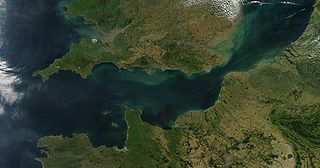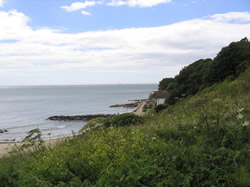Related Research Articles

The English Channel, also known as the Channel, is an arm of the Atlantic Ocean that separates Southern England from northern France. It links to the southern part of the North Sea by the Strait of Dover at its northeastern end. It is the busiest shipping area in the world.

The Hanseatic League was a medieval commercial and defensive confederation of merchant guilds and market towns in Central and Northern Europe. Growing from a few North German towns in the late 12th century, the League expanded between the 13th and 15th centuries and ultimately encompassed nearly 200 settlements across seven modern-day countries, ranging from Estonia in the north and east, to the King's Lynn, England in the west, and Kraków, Poland, in the south.

The Isle of Wight is an island, English county and unitary authority in the English Channel, 2 to 5 miles off the coast of Hampshire, across the Solent. It is the largest and second-most populous island in England. Referred to as "The Island" by residents, the Isle of Wight has resorts that have been popular holiday destinations since Victorian times. It is known for its mild climate, coastal scenery, and verdant landscape of fields, downland, and chines. The island is historically part of Hampshire. The island is designated a UNESCO Biosphere Reserve.

The First Anglo-Dutch War, or First Dutch War, was a naval conflict between the Commonwealth of England and Dutch Republic. Largely caused by disputes over trade, it began with English attacks on Dutch merchant shipping, but expanded to vast fleet actions. Despite a series of victories in 1652 and 1653, the Commonwealth was unable to blockade Dutch trade, although English privateers inflicted serious losses on Dutch merchant shipping.

Poole Harbour is a large natural harbour in Dorset, southern England, with the town of Poole on its shores. The harbour is a drowned valley (ria) formed at the end of the last ice age and is the estuary of several rivers, the largest being the Frome. The harbour has a long history of human settlement stretching to pre-Roman times. The harbour is extremely shallow, with one main dredged channel through the harbour, from the mouth to Holes Bay.

Red Funnel, the trading name of the Southampton Isle of Wight and South of England Royal Mail Steam Packet Company Limited, is a ferry company that carries passengers, vehicles and freight on routes between the English mainland and the Isle of Wight. High-speed foot passenger catamarans, known as Red Jets, run between Southampton and Cowes, while vehicle ferries run between Southampton and East Cowes.

The Isle of Wight is rich in historical and archaeological sites, from prehistoric fossil beds with dinosaur remains, to dwellings and artefacts dating back to the Bronze Age, Iron Age, and Roman periods.

The Royal Scots Navy was the navy of the Kingdom of Scotland from its origins in the Middle Ages until its merger with the Kingdom of England's Royal Navy per the Acts of Union 1707. There are mentions in Medieval records of fleets commanded by Scottish kings in the twelfth and thirteenth centuries. King Robert I developed naval power to counter the English in the Wars of Independence (1296–1328). The build up of naval capacity continued after the establishment of Scottish independence. In the late fourteenth century, naval warfare with England was conducted largely by hired Scots, Flemish and French merchantmen and privateers. King James I took a greater interest in naval power, establishing a shipbuilding yard at Leith and probably creating the office of Lord High Admiral.
The Steelyard, from the Middle Low German Stâlhof, was the kontor of the Hanseatic League in London, and their main trading base in England, from the 13th and 16th centuries. The main goods that the League exported from London were wool and from the 14th century woollen cloths. An important import good was beeswax. The kontor tended to be dominated by Rhenish and Westphalian traders, especially from Cologne.

The Maritime history of Europe represents the era of recorded human interaction with the sea in the northwestern region of Eurasia in areas that include shipping and shipbuilding, shipwrecks, naval battles, and military installations and lighthouses constructed to protect or aid navigation and the development of Europe. Europe is situated between several navigable seas and intersected by navigable rivers running into them in a way which greatly facilitated the influence of maritime traffic and commerce. Great battles have been fought in the seas off of Europe that changed the course of history forever, including the Battle of Salamis in the Mediterranean, the Battle of Gravelines at the eastern end of the English Channel in the summer of 1588, in which the “Invincible” Spanish Armada was defeated, the Battle of Jutland in World War I, and World War II’s U-boat war.

The Spanish Armada was a Spanish fleet that sailed from Lisbon in late May 1588, commanded by the Duke of Medina Sidonia, an aristocrat without previous naval experience appointed by Philip II of Spain. His orders were to sail up the English Channel, join with the Duke of Parma in Flanders, and escort an invasion force that would land in England and overthrow Elizabeth I. Its purpose was to reinstate Catholicism in England, end support for the Dutch Republic, and prevent attacks by English and Dutch privateers against Spanish interests in the Americas.
The English Channel naval campaign of the years 1338 and 1339 saw a protracted series of raids conducted by the nascent French navy and numerous private raiders and pirates against English towns, shipping and islands in the English Channel, which caused widespread panic, damage and financial loss to the region and prompted a serious readjustment of English finances during the early stages of the Hundred Years' War. This period was then followed by a French disaster caused by over-confidence and a reversing of roles which had a major effect on the English successes of the next two decades; this result was by no means assured until late 1339 and had the French fought a little longer they might have ended the war before it had really begun.

The Battle of Bonchurch took place in late July 1545 at Bonchurch on the Isle of Wight. No source gives the precise date, although 21 July is possible from the sequence of events. The battle was a part of the wider Italian War of 1542–1546, and took place during the French invasion of the Isle of Wight. Several landings were made, including at Bonchurch. Most accounts suggest that England won the battle, and the French advance across the island was halted.

The North Sea has an extensive history of maritime commerce, resource extraction, and warfare between among the people and nations on its coasts.

The French invasion of the Isle of Wight occurred during the Italian Wars in July 1545. The invasion was repulsed.
The Anglo-Hanseatic War was a conflict fought between England and the Hanseatic League, led by the cities of Gdańsk and Lübeck, that lasted from 1469 to 1474. Causes of the war include increasing English pressure against the trade of the Hanseatic cities on the southern coast of the Baltic Sea.
The Armada of 1779 was a combined Franco-Spanish naval enterprise intended to divert British military assets, primarily of the Royal Navy, from other war theatres by invading the Kingdom of Great Britain during the American Revolutionary War. This action was a part of the wider Anglo-French War (1778–1783). The proposed plan was to seize the Isle of Wight and then capture the British naval base of Portsmouth. Ultimately, no fleet battles were fought in the Channel and the Franco-Spanish invasion never materialized. This threat to Great Britain prompted comparisons to the earlier Spanish Armada of 1588.
The maritime history of England involves events including shipping, ports, navigation, and seamen, as well as marine sciences, exploration, trade, and maritime themes in the arts of England. Until the advent of air transport and the creation of the Channel Tunnel, marine transport was the only way of reaching the rest of Europe from England and for this reason, maritime trade and naval power have always had great importance. Prior to the Acts of Union in 1707, the maritime history of the British Isles was largely dominated by England.

The information about Scotland's domestic and foreign trade during the Middle Ages is limited. In the early Middle Ages the rise of Christianity meant that wine and precious metals were imported for use in religious rites. Imported goods found in archaeological sites of the period include ceramics and glass, while many sites indicate iron and precious metal working. The slave trade was also important and in the Irish Sea it may have been stimulated by the arrival of the Vikings from the late eighth century.
Baltic maritime trade began in the Late Middle Ages and continued to develop into the early modern period. During this time, ships carrying goods from the Baltic and North Sea passed along the Øresund, or the Sound, connecting areas like the Gulf of Finland to the Skagerrak. Over a period of 400 years, maritime powers in the east and west struggled to control these markets and the trade routes between them. The Baltic trading system of this era can be explained as beginning with the Hanseatic League and ending with the Great Nordic War.
References
- ↑ "Seakeeping-p1-art". florilegium.org. Retrieved 2015-04-13.
- ↑ "BBC - h2g2 - Isle Of Wight Shipwrecks: The Hundred Years War". bbc.co.uk. Retrieved 2015-04-13.
- ↑ Myers, A.R. (1995). English Historical Documents, 1327-1485. Routledge. p. 259. ISBN 9780415143691 . Retrieved 2015-04-13.